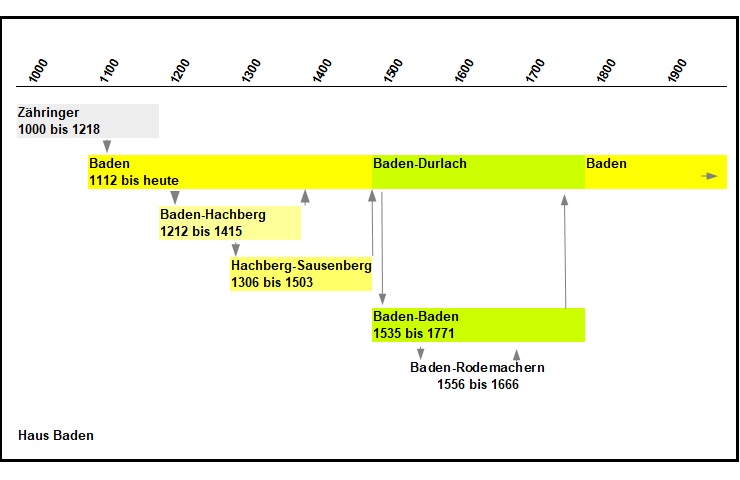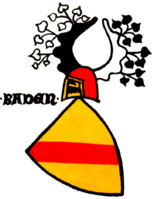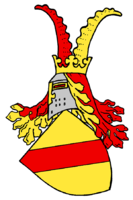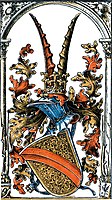House Baden
The Baden house has belonged to the German nobility for centuries . The roots of the noble family lie in Breisgau , Ortenau , Baar , Hegau and Thurgau . Already in the High Middle Ages, the common ancestors of the Zähringer family and the later House of Baden had count rights in the areas mentioned and were thus one of the important families in the southwest of the Duchy of Swabia .
Historical background
The progenitor of the house was Hermann I , the eldest son of Duke Berthold I of Carinthia . Hermann's son, Hermann II , Count im Breisgau , was the first to name himself in 1112 after the Hohenbaden Castle of Baden . He had acquired the area around Baden-Baden by balancing the Zähringer with the Hohenstaufen to form the Duchy of Swabia and from 1112 he held the margrave title inherited from his father - originally that of the margraviate of Verona . This is how the new margraviate of Baden came into being .
Territory expansions followed: The original territory on the middle Neckar around Backnang , Besigheim and the newly acquired areas on the Upper Rhine could be connected through the acquisition of Pforzheim in 1219 , this in 1442 through shares in the lords of Lahr and Mahlberg with the Breisgau. From 1190 there was a Hachberg line , which was bought back by Margrave Bernhard I in 1415 , albeit without the Sausenberg rulership , which only fell to the Baden main line in 1503.
In 1535, the margraviate of Baden-Baden and Baden-Durlach was created from the margraviate of Baden by dividing the inheritance . Margrave Karl Friedrich von Baden-Durlach inherited the Catholic line of Baden-Baden in 1771 and reunited the two margravates. Karlsruhe became the residence , where from 1715 the new baroque state capital was built near Durlach Castle . At the end of the Holy Roman Empire he rose first to the position of elector and then - after the dissolution of the empire in 1806 - to the position of grand duke .
From 1830, the morganatic sideline, descended from Luise Karoline von Hochberg , took over the ducal dignity . Their assumption of government was fraught with rumors that Kaspar Hauser was a son of Grand Duke Karl , who died in 1818 , and was thus the rightful candidate for the throne. The inheritance claims of the Hochberger sideline had already been internationally recognized in 1818 at the Aachen Congress . This line played an important role both in the founding of the German Empire , when Grand Duke Friedrich I was the first to shout "Long Live Kaiser Wilhelm" in the Hall of Mirrors of the Palace of Versailles, and in the dissolution of the German Empire in 1918, as Chancellor Maximilian von On November 9th Baden announced the abdication of Kaiser Wilhelm II .
Zähringer

The equation of the house with the family of the Zähringer, which is widely used in literature, is basically historically imprecise. The misunderstanding is based on the beginnings of regional and house history research by Johann Daniel Schöpflin . Both houses have a common progenitor, Duke Berthold I of Carinthia , but he himself never used the name Duke of Zähringen . In the 19th century, the House of Baden forced its equation with the House of Zähringen for propaganda purposes in order to historically underpin the claim to the new areas of South Baden and the title of Grand Duke.
Personalities
coat of arms
The family coat of arms (Zähringen) shows a red diagonal right bar in gold. On the helmet with red and gold helmet covers a red and a gold ibex horn .
Family coat of arms in the Zurich coat of arms roll , approx. 1335-1345
Coat of arms graphic by Otto Hupp in the Munich calendar of 1895
After the abolition of the monarchy
On November 22, 1918, the last Grand Duke of Baden thanked during the November Revolution for himself and his successors entitled to inherit and led since then as head of the House of Baden named Margrave of Baden . The newly founded Republic of Baden took over the residential palace in Karlsruhe as well as the palaces in Rastatt , Mannheim , Schwetzingen and Bruchsal in state ownership and in a severance agreement left the palaces in Baden-Baden and Salem with the art treasures in them to the House of Baden . Because the grand ducal couple Friedrich II and Hilda had no male descendants entitled to inheritance, they adopted their great-nephew Berthold von Baden .
To cover high debts that arose much later, Max Margrave von Baden sold Eberstein Castle (Gernsbach) in 2000 ; He also sold the New Castle Baden-Baden to an investor from Kuwait in 2003, after auctioning off the art treasures it contained . The castle in Salem was taken over by the state of Baden-Württemberg in 2009 , but the family retained the right to live in a wing. In 2006 the attempt by Bernhard Prince von Baden and the state government of Baden-Württemberg under Günther Oettinger to attract funds for the renovation of the castle by offering cultural assets from the Baden state library for sale. This incident became known as the Karlsruhe cultural property affair and was accompanied by heated debates in the state parliament of Baden-Württemberg .
Heads of the House of Baden since 1918
The rulers of the House of Baden until 1918 can be found in the list of Margraves and Grand Dukes of Baden . Details on the genealogy of the House of Baden can be found in the family tree of the House of Baden .
The following table lists the former heads of the house after the fall of the monarchy:
|
Since 1963, Max Margrave of Baden has been the head of the House of Baden, which - even if it no longer exists in the public-law sense since 1919 - as a family of the historical nobility .
Personalities
Important members of the house were:
- Bernhard II of Baden (1428 / 29-1458), blessed of the Roman Catholic Church
- Ludwig Wilhelm von Baden-Baden (1655–1707), called Türkenlouis
- Karl Wilhelm von Baden-Durlach (1679–1738), founder of Karlsruhe
- Karl Friedrich , since 1771 margrave of the united state of Baden and 1806 founder of the Grand Duchy
- Friedrich I , Grand Duke of Baden from 1856 to 1907
Residences of the House of Baden
In addition to the Hohenbaden family castle, the Yburg and from 1219 the old castle in Ettlingen belonged to the medieval seats of the margraves of Baden . In 1503 the castles Rötteln , Badenweiler and Sausenburg were added in the newly acquired Markgräflerland . After the division of the country in 1535, the rulers of the Lower Margraviate initially resided in Pforzheim and from 1565 in the Karlsburg castle in Durlach . Around the same time, the renaissance castles of the Upper Margraviate in Baden-Baden and Ettlingen were built through the expansion of late Gothic buildings . After the castle in Baden-Baden was burned down by French troops in the Palatinate War of Succession in 1689, the new residence of the Baden-Baden Line was built in the market town of Rastatt , while the Durlacher Line moved into the baroque castle in Karlsruhe , which was newly built in 1718 . The government authorities of the margraviate were relocated to Basel from 1689 to 1697 . Margrave Friedrich Magnus found refuge in Basel's Markgräflerhof from 1703–1705 and 1707 during the War of the Spanish Succession . Karl Friedrich von Baden-Durlach, who also ruled the Margraviate of Baden-Baden from 1771 and the newly created Grand Duchy of Baden from 1806 , took over the former baroque residences of the Electors of the Palatinate in Mannheim and Schwetzingen and those of the Prince-Bishops of Speyer in Bruchsal around 1802 . In Heidelberg and Freiburg, existing palaces were converted into local residences. From 1891 the Hereditary Grand Ducal Palace in Karlsruhe was built for the heir to the throne . After the revolution of 1918, the Reichsabbey of Salem , which had already been secularized in 1804, became the family's residence. After the sales in the 2000s, only Staufenberg Castle (Black Forest) with its winery is still owned by the head of the House of Baden, while a sideline lives in Zwingenberg Castle .
Karlsburg in Karlsruhe-Durlach
Hereditary Grand Ducal Palace in Karlsruhe
Yburg (Black Forest)
Zwingenberg Castle on the Neckar
Burial of the sexes

In 1116 Margrave Hermann I founded the Augustinian Canons' Abbey of Backnang , which was then the family's burial place until 1248 . In 1248 the burial place was moved to the newly founded Lichtenthal Abbey . From Bernhard I († 1431) the collegiate church in Baden (-Baden) served as a burial place, the members of the Baden-Baden line were also buried here.
From 1535 the margraves of Baden-Durlach used the castle and collegiate church of St. Michael in Pforzheim as a burial place (last burial in 1860). Most of the members of the grand ducal family of Baden were buried in the Evangelical City Church in Karlsruhe. In the 1890s, the grand ducal burial chapel in Karlsruhe's Hardtwald was built as a mausoleum . Also worth mentioning is the Karlsruhe pyramid as a tomb for the city's founder Karl Wilhelm .
Since the abolition of the monarchy, family members have mostly been buried in Salem .
The main burial places for the Baden branch lines were the Tennenbach Monastery for Baden-Hachberg, the Röttler Church for Hachberg-Sausenberg and the St. Nicholas Church of Rodemachern for Baden-Rodemachern.
Morganatic sidelines
In addition to the Counts of Hochberg (later declared to be entitled to inheritance by house law), the House of Baden has other branches from morganatic marriages or illegitimate relationships. The following list does not claim to be complete:
Margrave Friedrich VI. had an illegitimate relationship with Johanna Bayer von Sendau, (1636–1699) whose descendants received the title of barons of Münzesheim .
Carl Friedrich Hermann von Freystedt , an illegitimate son of Margrave Karl Friedrich, is the progenitor of the Freystedt branch .
Karl Wilhelm Eugen von Freydorf , a son of Christoph von Baden-Durlach , is the progenitor of the branch line from Freydorf .
Wilhelm Ludwig von Seldeneck , a son of Wilhelm Ludwig von Baden-Durlach and nephew of Margrave Karl Friedrich, is the progenitor of the Seldeneck branch .
Karl August von Baden-Durlach , an uncle of Margrave Karl Friedrich, founded the Ehrenberg branch .
Grand Duke Ludwig I founded the short-lived family of the Counts of Langenstein - in the male line , which in the female line in the House of Douglas-Langenstein . passed over. In addition, Ludwig I is also the progenitor of the illegitimate branch of the von Steinberg family.
Prince Karl (1832–1906) founded with his morganatic wife Rosalie Luise Freiin von Beust (1845–1908), daughter of Baron Wilhelm von Beust (1805–1875), who through her mother Emilie von Beust (1820–1878) the granddaughter of the Baden General Staff Doctor Wilhelm Meier (1785-1853) and great-granddaughter of the Baden Privy Councilor Emanuel Meier (1746-1817) was and was raised to Countess of Rhena on the occasion of their marriage, the branch line of the Counts of Rhena, which, however, with their son Friedrich in 1908 again died out.
The Baden family was not lacking in descendants, but rather in marriages befitting their rank.
literature
- Kathrin Ellwarth: The Baden House in the past and present. Börde-Verlag, Werl 2008, ISBN 978-3-9811993-1-4 .
- Timo John: The Grand Dukes and Grand Duchesses of Baden. Kunstverlag Josef Fink, Lindenberg 2008, ISBN 978-3-89870-409-0 .
See also
The family of the Barons of Baden is not related to the noble house of Baden.
Web links
- Entry on almanachdegotha
- Heinz Krieg: BADEN, MGF.EN VON. In: Handbook Courts and Residences in the Late Medieval Empire - Volume 15.I, pp. 37-43 online
Individual references / comments
- ^ Karl Stiefel : Baden - 1648–1952 , Karlsruhe 1977, p. 67.
- ^ Fr. Cast: Süddeutscher Adelsheros , Stuttgart 1845, Second Section, First Volume, pp. 251/252
- ^ Fr. Cast: Süddeutscher Adelsheros , Stuttgart 1845, Second Section, First Volume, p. 250.
- ↑ s. Edmund von der Becke-Klüchtzner: Stamm-Tafeln of the nobility of the Grand Duchy of Baden: a newly edited book of nobility , Baden-Baden, 1886, p. 434 (online) ( Memento of the original from March 8, 2014 in the Internet Archive ) Info: The archive link was used automatically and not yet checked. Please check the original and archive link according to the instructions and then remove this notice.
- ^ Fr. Cast: Süddeutscher Adelsheros , Stuttgart 1845, Second Section, First Volume, pp. 185/186
- ↑ s. Edmund von der Becke-Klüchtzner: Stamm-Tafeln of the nobility of the Grand Duchy of Baden: a newly edited book of nobility , Baden-Baden, 1886, p. 117 (online) ( Memento of the original from March 8, 2014 in the Internet Archive ) Info: The archive link was used automatically and not yet checked. Please check the original and archive link according to the instructions and then remove this notice.
- ↑ s. Edmund von der Becke-Klüchtzner: Stamm-Tafeln of the nobility of the Grand Duchy of Baden: a newly edited book of nobility , Baden-Baden, 1886, p. 114 (online) ( Memento of the original from March 8, 2014 in the Internet Archive ) Info: The archive link was used automatically and not yet checked. Please check the original and archive link according to the instructions and then remove this notice.
- ^ Fr. Cast: Süddeutscher Adelsheros , Stuttgart 1845, Second Section, First Volume, pp. 124/125
- ↑ s. Edmund von der Becke-Klüchtzner: Stamm-Tafeln of the nobility of the Grand Duchy of Baden: a newly edited book of nobility , Baden-Baden, 1886, p. 456 (online) ( Memento of the original from March 8, 2014 in the Internet Archive ) Info: The archive link was used automatically and not yet checked. Please check the original and archive link according to the instructions and then remove this notice.























